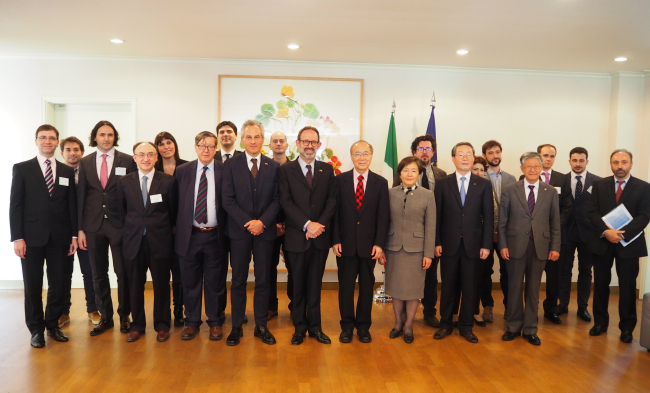The Italian Embassy in Seoul hosted a networking reception on Thursday, marking Italian Research Day, which celebrates the country’s scientific achievements and supports research exchanges abroad on April 15, the birthday of Leonardo da Vinci.
The diplomatic mission organized the event in cooperation with its Science and Technology Office, inviting 25 Italian scientists here, presidents of various universities, researchers and journalists. The day is organized by the Italian Ministry of Education, University and Research.
“The aim of the Italian Research Day is to enhance the skills of our researchers abroad and quality of their research, and to promote concrete measures and investments that enable them to continue their careers at home,” said Italian Ambassador to Korea Marco della Seta in a speech.
“While Korea has excellence in infrastructure, equipment and financial investment in scientific research, Italy has a long tradition of excellence in basic sciences, university education and research brainpower. Therefore our countries can enhance mutually complementary collaborations and exploit many synergies across diverse disciplines.”
The community of 25 Italian scientists and researchers in Korea study and work at prestigious institutions across the country, ranging from basic sciences such as physics, astrophysics and mathematics to nanoscience, green energy and biotechnology.
According to the embassy, there are an increasing number of Italian doctoral and postdoctoral researchers in Korea, who are drawn by unique professional, cultural and networking opportunities.
“For young Italian scientists spending a period in Korea either as a doctoral candidate, postdoc scholar or institutional researcher, they have opportunities to join cutting-edge programs, immerse in advanced scientific environments, and nurture their skills for successful careers,” Seta said. “For Korean faculties and research managers at local institutions, hosting Italian researchers is an excellent investment, because they come with grounded education universally recognized and appreciated.”
The quantity of scientific and technological research in Italy is smaller than in other European countries, said the envoy, but the quality is high, as the research is productively translated into scientific publications or engineering breakthroughs. Italy has produced 14 Nobel laureates in scientific fields.
Italy is particularly strong in mechanical, aerospace and electrical engineering as well as multimedia technology, according to the embassy.
In 2015, Italy had 215,000 scientists, then 12th in the world, and its investments in research and development topped 24 billion euros ($30 billion). The country consistently ranks in the top 10 of countries producing the highest number of scientific publications.
The Italian Foreign Ministry has delegated some 25 science attaches to embassies worldwide to strengthen international academic cooperation. In Asia and Oceania, they are in Seoul, Beijing, Shanghai, Chongqing, Tokyo, Hanoi, New Delhi and Canberra, said Francesco Canganella, a science attache at the Seoul embassy and head of its Science and Technology Office.
“Our science diplomacy informs our foreign policy objectives and facilitates international cooperation in related fields,” he said.
On the government level, the two countries’ ministries of foreign affairs and ministries of science have established a bilateral cooperation program in science and technology for 2016-2018, through which six projects are funded. Their Joint Research Laboratory oversee projects in chemistry and membrane technology, fuel cells technology and technologies applied to cultural restoration.
“Since 2003, Italy and Korea have organized Korea-Italy Science and Technology Forums in Seoul, Daegu, Pisa and Naples,” said Enrico Drioli, a professor of energy engineering at Hanyang University. Hanyang University and the University of Calabria recently signed an agreement to offer a joint doctoral program in science.
There will be various workshops and symposiums in both Korea and Italy this year, focusing on human microbiome, infectious diseases, hydrogeology, occupational medicine, underground physics, biorobotics, the internet of things and sustainable fisheries.
“Leonardo da Vinci, renowned primarily as a painter, was also a very serious scientist who conducted innovative studies in science and technology well ahead of his time. He was an all-around man, a true Renaissance polymath who pioneered almost all of academic fields from the arts and history to the sciences and medicine,” said Ewha Womans University President Kim Hei-sook.
“As an academic, I believe Leonardo da Vinci’s name will reverberate in the minds of those preparing our young generations for the ‘fourth industrial revolution’ through education. The fourth industrial revolution is said to usher in advancements in robotics, virtual reality, cloud technology, big data, artificial intelligence, the internet of things and other technologies. At the same time, it is characterized by the convergence of arts and technologies, and the blurring of lines among the cultural, physical, digital and biological worlds.”
She added, “We are asked to educate our young students to become all-around persons. Leonardo da Vinci deeply inspires us in this aspect.”
There has been fruitful bilateral cooperation between Ewha and Italian institutions at both faculty and student levels, the president said, noting strong collaborations have occurred in science and technology, particularly in food sciences and environmental sciences. Two Italian scientists in physics and nanoscience fields are currently at Ewha: Claudio Saracini at the Department of Chemistry and Nano Science since 2016, and Fabio Donati at the Physics Department since 2017.
Wohn Kwang-yun, chairman of the National Research Council of Science and Technology, said Italy is special for his institution, which was established in 2014 and signed its first memorandum of understanding with the National Research Council of Italy. The two institutions have fostered bilateral cooperation, he stressed, mentioning several joint projects in astronomy and space science.
“The world is more global than ever before, and the flux of researchers to all corners of the globe allows new possibilities for spreading information and gleaning of new knowledge,” said president of the Institute for Basic Science, Kim Doo-chul. “Italian researchers here not only benefit Korea and Italy, but the whole of science. Su questo non ci piove! (no doubt about it!)”
The Institute for Basic Science has collaboration schemes with several Italian institutions, and will host with them a forum on underground physics as part of the Italian-Korean Symposium later this year.
By Joel Lee (
joel@heraldcorp.com)








